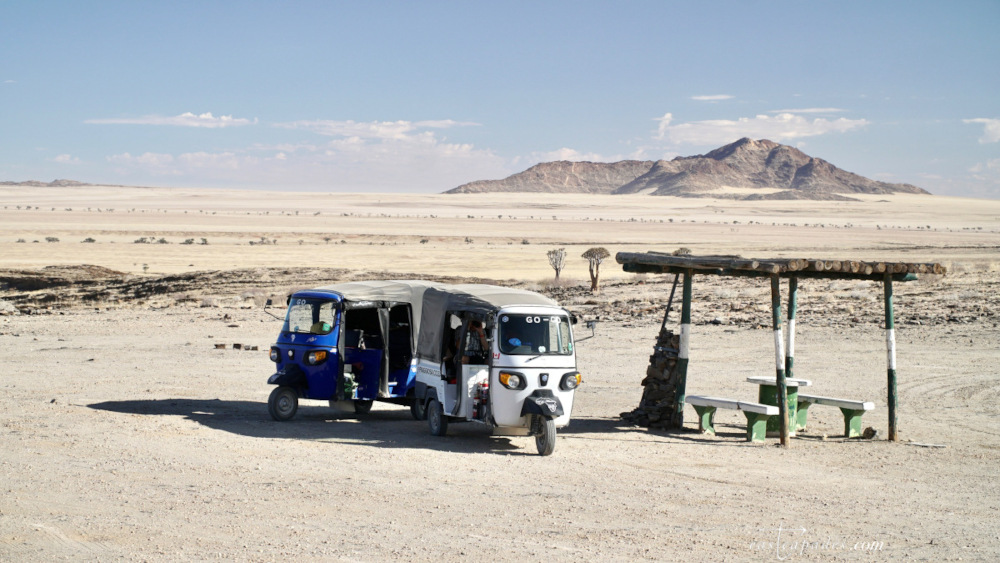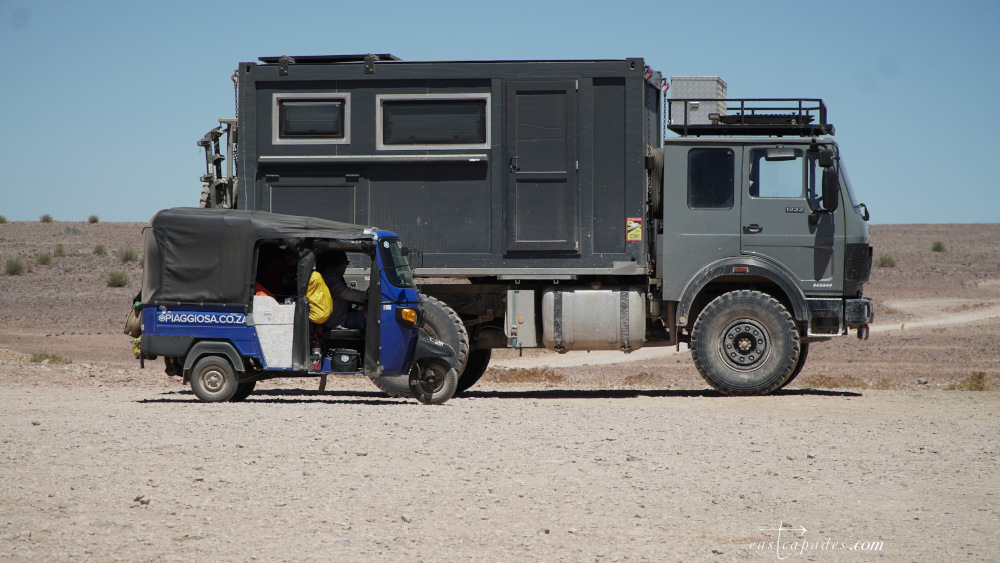Tuk-tuks (or scooter vans) are common in Asian cities. But could they handle Africa’s gritty gravel roads? Armed with the Tracks4Africa Atlas, one group of Belgian adventurers determined to find out. By Magriet Kruger
Belgian couple Frank Janssens and Sylvia Margraff, based in Vancouver, are known as adventurous spirits. They’ve spent months at a time exploring places from Iceland to India on their bicycles. “For this trip we planned to travel with my sister, Carine Janssens, and her partner, Quentin Malrain, who live in France. They usually overland in their converted 1982 Citroen 2CV panel van. So we thought to compromise between four wheels and two wheels and the result was a tuk-tuk,” explains Frank.

Their original plan had been to make their way from Nairobi down to Cape Town. But when they struggled to find tuk-tuks for purchase in Kenya, they hunted elsewhere. When they came across a Piaggio dealer in Johannesburg, their plan became reality. They purchased three tuk-tuks since a third couple was joining them for the first leg of the trip. Each six-seater tuk-tuk has space for a driver and passenger up front, with two benches for four passengers in the back. The overlanders removed the back seats and built wooden storage boxes for their luggage. On 19 January, they set off on their tuk-tuk overlanding adventure through Southern Africa.

Exploring South Africa
The first destination was the Kruger National Park, where the tuk-tuks weren’t permitted to enter due to their noise and being open. But a guided game drive revealed the park’s many charms. “In less than two hours we saw almost everything,” they recall. Even at four months into their trip, Kruger remains a highlight. It was just getting to the park that was a challenge. Because the tuk-tuks were brand new with zero kilometres on the odometer, the engines had to be run in. That meant not exceeding 30km/h for the first 1,000km and no more than 10km/h going uphill.
From Kruger their route led through eSwatini’s rolling hills and into Lesotho’s bigger mountains. The tuk-tuks didn’t love the steep climbs and more than once the overlanders had to get out and push. The weather also became changeable as the elevation increased – somewhat of a challenge with a vehicle that doesn’t seal. But the beauty of the unfolding landscape kept them going. They continued on to the Wild Coast and into the Karoo.

Any keen overlander knows that Swartberg Pass is a bucket list tick. But could the tuk-tuks handle it? Some people doubted it. “We did it in about two hours,” recounts Frank. “Yes, we stopped on the uphill, but only to take pictures.”

Route 62 brought the tuk-tuks to the Western Cape and the Winelands. “South Africa was really easy travelling and we loved the good and affordable wine. And when you’re travelling in a tuk-tuk, people are so friendly. Even the cops: they might have stopped us for bribes, but they would end up taking selfies.”
Into Namibia and beyond
Travelling up from Cape Town, the tuk-tuks got off the N7 whenever possible to enjoy the back roads leading to Namibia. Inside the dinky vehicles, they could feel the heat building and smell the change in the air. The first mandatory stop was the Fish River Canyon, with the vastness of the landscape bringing Namibia’s appeal home. “It is unlike anywhere we’ve been before. Namibia is just unbelievable.” Cruising along the good gravel roads, the tuk-tuks made their way to Lüderitz, Kolmanskop and Sossusvlei.

It was while enjoying a coffee at a lodge near Sossusvlei that the foursome heard that unmistakable lawnmower sound. There was another tuk-tuk, maybe even two, travelling along the road… And so they met the crew of Tuk South, who have been travelling in their own tuk-tuks for over 17 months. The travellers exchanged war tales and tips, the Tuk South crew enviously eyeing the newer models with their greater ground clearance.

Also read: Tuk South’s trip for rangers
Another fortuitous encounter was at Spitzkoppe, where the two tuk-tuks pulled up next to a distinctive orange vehicle. It was Jimny Cricket, the vehicle of Craig and Kirsten Marshall, who were in Namibia capturing footage for Tracks4Africa.

Watch now: Cape to Etosha in Jimny Cricket
The road led onwards to Etosha and into the Okavango. In Chobe National Park, the foursome saw the unforgettable sight of elephants wading through waterlilies. When Tracks4Africa spoke to the travellers, they were in Zimbabwe, slowly making their way back to Johannesburg. We asked them to share what it’s like overlanding by tuk-tuk.
Key considerations
Wondering if overlanding in a tuk-tuk could be for you? Read on to get the lowdown from these adventurers.
Speed, distances and fuel
A tuk-tuk can reach up to 50km/h on the open road. But going uphill the speed drops to 15km/h; although it again increases to 55km/h heading down the other side. This is something to consider when planning your distances. “As cyclists, we’re used to doing around 85km a day,” says Frank. “Quentin and Carine would usually cover 200km a day in their car. So again we compromised and settled on 100-150km a day in the tuk-tuks.”
Bear in mind that in a tuk-tuk you are much more exposed to the conditions. You’re in the dust and the heat, it’s windy and noisy. And because these vehicles don’t have any suspension, you’re aware of every bump in the road. “Driving can be tiring, so we stop every two hours to have a coffee and take a break.”

Another consideration when planning your route is where you can fill up. But you might be surprised how far you can go in this three-wheeler. “The tuk-tuk has a 10L tank and we travel with two 10L fuel canisters. It’s really light on fuel: we can get up to 100km on three litres. So we can comfortably cover 700-800km before needing to refuel. Thanks to its 400cc diesel engine, it’s a really economical way to travel.”
Road conditions
“Early on in our trip, we met some overlanders in a 4×4 who expressed skepticism about us doing gravel roads in the tuk-tuks. When we encountered them again later, they were amazed that we had done exactly the same route they had done. We had done the same gravel tracks and sandy roads, seen exactly the same things. We were just a bit more dusty and dirty at the end, that’s all. We’ve done more than 2,000km of gravel roads by now.”

Although the majority of gravel roads are fine, the tuk-tuk overlanders say “washboard” roads are ones to watch out for. Due to the small wheels, you will feel every bit of the corrugation. It’s also best to avoid very sandy roads, although the tuk-tuk is light enough that you can push it out if you get stuck. “With a tuk-tuk, you’re never really stuck,” they say.

But the type of road does have a major impact on route planning. “What we found really helpful about the Tracks4Africa Atlas is that it gives information about the distance, travel time and road surface. We also look at sights along the way for our planning. All this information is really helpful. Especially for cyclists, motorbike riders and tuk-tuk drivers, because the road surface makes a huge difference. If the road is gravel or sand, we have to be realistic about the distance we can do and where we will spend the night.”
Maintenance
“As bikepackers, we were afraid of overlanding by car, because what if the engine is difficult to fix?,” says Frank. Fortunately, the tuk-tuk is very straightforward. After a particularly bumpy stretch of road, the overlanders check that all the screws are still in place. Other basic maintenance involved changing the oil and rotating the wheels at 5,000km. “We’ve had no punctures or engine troubles. Quentin, who is our mechanic, is almost frustrated because there is not enough to do,” says Sylvia.

Slow travel
Travelling by tuk-tuk lends itself to slow travel, where you take your time and stop frequently. “We are not in a rush. Our goal is to meet people and understand the country, not to go fast,” they say. Their travel philosophy of immersing themselves in the culture of a place means they don’t have a fixed plan. “We take it day by day and sometimes even during the day we change our plan – based on the roads, the weather conditions, our moods. If we meet someone and we’re invited to discover something, we want to do so.”
And they have definitely been meeting people along the way. These quirky vehicles catch people’s attention wherever they go. “We were quite surprised to see how much joy and entertainment tuk-tuks bring on the road. People wave and they want to take pictures. When we stop, we are always surrounded by a lot of people who ask questions.”
Affordability
For the two couples coming from abroad, it worked out affordably to buy and customise their own tuk-tuks. For the price of a new vehicle, they could travel for twice as long as when renting a 4×4. The plan is to sell the tuk-tuks at the end of their trip. “They will have only around 13,000km on the clock. And these vehicles can easily do 300,000km.”
Modifications for comfort
The overlanders removed the benches in the back and installed a storage box, effectively created a platform for sleeping. They then developed a system with foldout planks to extend that platform the full length of the interior. “It’s basically a campervan now and it’s pretty much the same size as a two-person tent inside. Initially, it took a while to set up our sleeping arrangements, but after more than 100 nights, it’s going more quickly. We also travel with a ground tent as backup.”

Further modifications include a mosquito net and a tarpaulin roof cover. The stitches in the canopy – after being worn away by the heat and wind on the road – were letting in the weather. Throwing a tarp over at night helped to keep the rain out.

Final thoughts
“It’s a great experience,” they say. And if you think travelling by tuk-tuk is something for students, know that these couples are around 60 years of age. But the most important word of advice for anyone considering overlanding by tuk-tuk? “If you want to do it, just do it,” says Sylvia.
See more of the adventures on Instagram: @eastcapades | @frjanssens | @ptiket3wheels




What a wonderful experience
The first adventurous soul has put up their hand, hear hear.
Yes if good back-up
As we were planning the project, we never thought about a back up and actually during the entire 6 months no back ups were needed. NO engine problems, NO punctures. Services have been done every 5000kms by ourselves. Everything went smoothly, even the few times we had to push in the deep sand or 22% grade climbs. The tuk tuks are so light that they do not require much effort to move on.